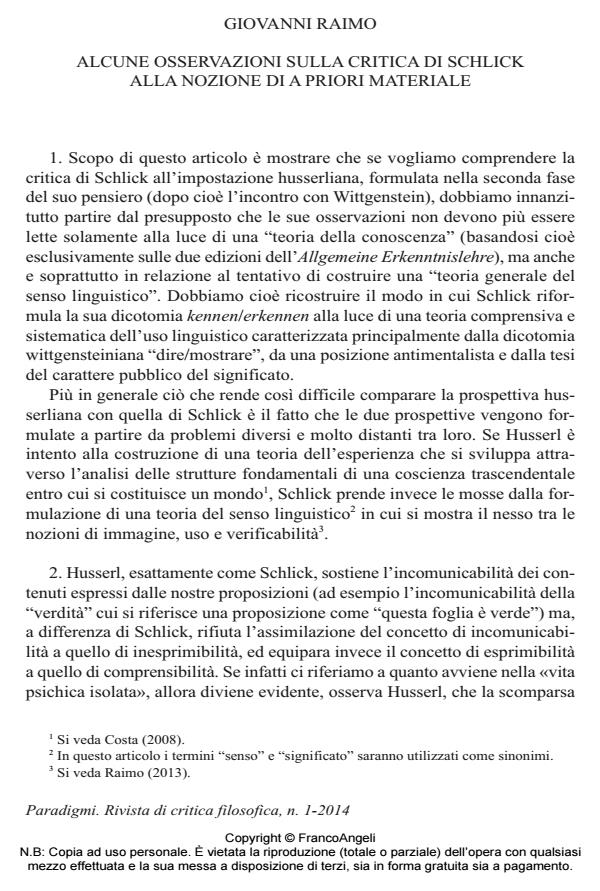Some Remarks Concerning Schlick’s Criticism of the Notion of the Material Apriori
Journal title PARADIGMI
Author/s Giovanni Raimo
Publishing Year 2014 Issue 2014/1
Language Italian Pages 14 P. 177-190 File size 547 KB
DOI 10.3280/PARA2014-001010
DOI is like a bar code for intellectual property: to have more infomation
click here
Below, you can see the article first page
If you want to buy this article in PDF format, you can do it, following the instructions to buy download credits

FrancoAngeli is member of Publishers International Linking Association, Inc (PILA), a not-for-profit association which run the CrossRef service enabling links to and from online scholarly content.
By reconsidering the debate between Husserl and Schlick on the notion of material a priori I aim to critically rethink the theoretical assumptions of the conceptual distinctions that are now being used in order to disentangle the link between perception, language and world. Rather than rebuilding all the ramifications and aspects of the issue concerning the material a priori, this article aims at showing that the difficulties the interpreters have always found in comparing the perspectives of Husserl and Schlick, resides in the difference between the respective starting points: while Husserl focuses on the formulation of a theory of transcendental experience in order to explain a non-psychologistic theory of intentionality, Schlick starts instead from a systematic and comprehensive theory of the language use, which is mainly characterized by Wittgenstein’s dicothomy say/show, the antimentalist perspective and the public character of meaning. However both philosophers want to answer the same question: what is the nature of the grasp that the concept has on the reality?
Keywords: Grammar, Material Apriori, Husserl, Perception, Schlick, Wittgenstein
- Costa V. (2008). A priori materiale. In: Ferraris M., a cura di. Storia dell’ontologia. Milano: Bompiani: 241-259.
- Cozzo C. (2008). Introduzione a Dummett. Roma-Bari: Laterza.
- Dummett M. (1993). Origins of Analytical Philosophy. Harvard: Harvard University Press (trad. it.: Origini della filosofia analitica. Torino: Einaudi, 2001).
- Husserl E. (1900-1901). Logische Untersuchungen. Halle: Max Niemeyer (trad. it.: Ricerche logiche. Milano: Il Saggiatore, 1968).
- Husserl E. (1913). Ideen zu einer reinen Phänomenologie und phänomenologischer Philosophie. Halle: Max Niemeyer (trad. it.: Idee per una fenomenologia pura ed una filosofia fenomenologica. Torino: Einaudi, 2000).
- E. Husserl (1970). Philosophie der Arithmetik, Husserliana, db. XII, Den Haag: Nijhoff. DOI: 10.1007/978-94-010-3187-5_
- Lanfredini R. (2003). Schlick and Husserl on the Essence of Knowledge. In: Parrini P., Salmon M. and Salmon W., eds. Logical Empiricism. Historical and Contemporary Perspectives. Pittsburgh: University of Pittsburgh Press: 43-57.
- Lanfredini R. (2006), La nozione fenomenologica di dato. In: Lanfredini R., a cura di. A priori materiale. Uno studio fenomenologico. Milano: Guerini e Associati: 59-94.
- Lanfredini R. (2012). Fenomenologia ed epistemologia. In: Cimino A. e Costa V., a cura di. Storia della fenomenologia. Roma: Carocci: 395-416.
- Marconi D. (1997a). Transizione. In: Marconi D., a cura di. Guida a Wittgenstein. Roma-Bari: Laterza: 59-101.
- Parrini P. (2012). Fenomenologia ed empirismo logico. In: Cimino A. e Costa V., a cura di. Storia della fenomenologia. Roma: Carocci: 81-110.
- Raimo G. (2013). La filosofia del linguaggio di Moritz Schlick. Immagine, uso e verificazione . Milano-Udine: Mimesis. Schlick M. (1918; 19252
- ). Allgemeine Erkenntnislehre. Berlin: Springer (trad. it.: Teoria generale della conoscenza. Milano: Franco Angeli, 1986).
- Schlick M. (1930). Gibt es ein materiales A priori? Wissenschaftlicher Jahresbericht der Philosophischen Gesellschaft der Universität zu Wien. Ortsgruppe Wien der Kant-Gesellschaft für das Vereinsjahr 1931/32 (Vienna, 1932): 55-65 (trad. it.: Esiste un a priori materiale? In: Forma e Contenuto. Torino: Boringhieri, 1987; 2008 ²: 167-179).
- Schlick M. (1932a). Form and Content. An Introduction to Philosophical Thinking. In: Gesammelte Aufsätze 1926-1936, Vienna: Gerold, 1938: 151-249 (trad. it.: Forma e Contenuto. Torino: Boringhieri, 1987; 2008 2).
- Schlick M. (1932b). Positivismus und Realismus. Erkenntnis, 3, 1 (trad. it.: Positivismo e Realismo. In: Pasquinelli A., a cura di. Il neoempirismo. Torino: Utet, 1969: 264-298).
- Schlick M. (1936). Meaning and verification. The philosophical review, 45: 339-369 (trad. it.: Significato e Verificazione. In: Pasquinelli A., a cura di. Il neoempirismo . Torino: Utet, 1969: 323-358).
- Spinicci P. (2000). Sensazione, percezione, concetto. Bologna: Il Mulino.
- Spinicci P. (2012). Fenomenologia e filosofia della percezione. In: Cimino A. e Costa V., a cura di. Storia della fenomenologia. Roma: Carocci: 377-394.
- Usberti G. (1995). Significato e conoscenza. Milano: Guerini scientifica.
- Wittgenstein L. (1922). Tractatus Logico-Philosophicus. London: Kegan (trad. it.: Tractatus Logico-Philosophicus. Torino: Einaudi, 1989). Wittgenstein L. (1953). Philosophische Untersuchungen. Oxford: Blackwell (trad. it.: Ricerche filosofiche. Torino: Einaudi, 1967).
- Wittgenstein L. (1964). Philosophische Bemerkungen. Oxford: Blackwell (trad. it.: Osservazioni filosofiche. Torino: Einaudi, 1992 2).
- Wittgenstein L. (1967). Wittgenstein und der Wiener Kreis. Oxford: Blackwell (trad. it.: Ludwig Wittgenstein e il circolo di Vienna. Firenze: Nuova Italia, 1975).
- Wittgenstein L. (1969). Über Gewissheit. Oxford: Blackwell (trad. it.: Della certezza. Torino: Einaudi, 1978).
- Wittgenstein L. (1980). Wittgenstein’s Lectures. Oxford: Blackwell (trad. it.: Lezioni 1930-1932. Milano: Adelphi, 1995).
- Wittgenstein L. (2000). The Big Typescript. Vienna: Springer (trad. it.: Big Typescript. Torino: Einaudi, 2002).
Giovanni Raimo, Alcune osservazioni sulla critica di Schlick alla nozione di a priori materiale in "PARADIGMI" 1/2014, pp 177-190, DOI: 10.3280/PARA2014-001010